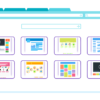In this blog post, we'll explore how to download data stored in local storage as HTML or TXT files using a WebView in an Android app. This is particularly useful for saving user data or creating downloadable content from your web-based application within your Android app. Let's dive into the details!
Prerequisites
To follow along with this tutorial, you will need:
- Android Studio installed on your computer
- Basic knowledge of Java and Android development
- A sample HTML file to load into the WebView
Setting Up Your Android Project
Create a New Android Project
Open Android Studio and create a new project. Choose "Empty Activity" and follow the setup wizard to create your project.
Add Required Permissions
In your AndroidManifest.xml file, add the necessary permissions to access the internet and write to external storage:
<uses-permission android:name="android.permission.INTERNET" />
<uses-permission android:name="android.permission.WRITE_EXTERNAL_STORAGE" />
Design Your Layout
Open activity_main.xml and add a WebView to your layout:
<LinearLayout xmlns:android="http://schemas.android.com/apk/res/android"
android:layout_width="match_parent"
android:layout_height="match_parent"
android:orientation="vertical">
<WebView
android:id="@+id/webView"
android:layout_width="match_parent"
android:layout_height="match_parent" />
</LinearLayout>
Accessing Local Storage Data
JavaScript Interface for Saving Files
Create a JavaScript interface to handle saving data as a text file or HTML file. This interface will allow JavaScript to call Java methods from the WebView.
public class WebAppInterface {
Context mContext;
WebAppInterface(Context c) {
mContext = c;
}
@JavascriptInterface
public void saveTxt(String data) {
try {
File downloadsDir = Environment.getExternalStoragePublicDirectory(Environment.DIRECTORY_DOWNLOADS);
File file = new File(downloadsDir, "localstorage.txt");
FileOutputStream fos = new FileOutputStream(file);
fos.write(data.getBytes());
fos.close();
Toast.makeText(mContext, "TXT file saved to Downloads", Toast.LENGTH_SHORT).show();
} catch (IOException e) {
e.printStackTrace();
}
}
@JavascriptInterface
public void saveHtml(String data) {
try {
File downloadsDir = Environment.getExternalStoragePublicDirectory(Environment.DIRECTORY_DOWNLOADS);
File file = new File(downloadsDir, "localstorage.html");
FileOutputStream fos = new FileOutputStream(file);
fos.write(data.getBytes());
fos.close();
Toast.makeText(mContext, "HTML file saved to Downloads", Toast.LENGTH_SHORT).show();
} catch (IOException e) {
e.printStackTrace();
}
}
}
Setting Up the WebView
In your MainActivity.java file, set up the WebView and add the JavaScript interface:
public class MainActivity extends AppCompatActivity {
private WebView webView;
@Override
protected void onCreate(Bundle savedInstanceState) {
super.onCreate(savedInstanceState);
setContentView(R.layout.activity_main);
webView = findViewById(R.id.webView);
webView.getSettings().setJavaScriptEnabled(true);
webView.addJavascriptInterface(new WebAppInterface(this), "AndroidInterface");
webView.loadUrl("file:///android_asset/yourfile.html");
}
}
JavaScript Code to Save Data
In your HTML file (yourfile.html), add the following JavaScript code to save the local storage data as TXT or HTML files:
<!DOCTYPE html>
<html>
<head>
<title>LocalStorage Data</title>
</head>
<body>
<script type="text/javascript">
window.onload = function() {
var data = localStorage.getItem('key');
// Save as TXT
if (data) {
window.AndroidInterface.saveTxt(data);
}
// Save as HTML
var htmlData = '<html><body>' + data + '</body></html>';
if (data) {
window.AndroidInterface.saveHtml(htmlData);
}
};
</script>
</body>
</html>
Conclusion
With the above steps, you now have an Android app that can download local storage data as either a TXT file or an HTML file using a WebView. This method provides a seamless way to handle and save data directly from your web-based application running inside an Android WebView.
Feel free to customize the code to suit your specific needs. Happy coding!













Leave a Reply